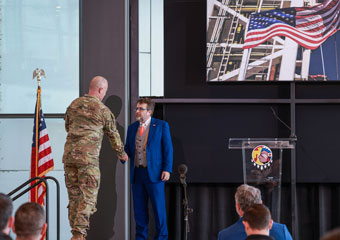
Oklahoma National Guard, OAIRE partner for Counter-UAS development symposium
Monday, March 18, 2024
Media Contact: Sydney Trainor | Communications and Media Relations Specialist | 405-744-9782 | sydney.trainor@okstate.edu
Oklahoma State University’s Oklahoma Aerospace Institute for Research and Education — in partnership with the Oklahoma National Guard — hosted a counter-uncrewed aircraft systems symposium March 12-13 at the Hamm Institute for American Energy in Oklahoma City.

"The Innovation Foundation at Oklahoma State University and OAIRE are proud to partner with the Oklahoma National Guard for the Counter-UAS Symposium," said Elizabeth Pollard, CEO and president of The Innovation Foundation at OSU. "OAIRE provides innovative air solutions to real-world problems, such as counter-UAS. Our partnership with federal, state and local government agencies and businesses advances our goal of fulfilling OSU's land-grant mission."
The symposium served as a collaborative environment for experts from the federal government, private industry, and academia to discuss policy, resource management, and the immediate security needs of the United States.
Dr. Jamey Jacob, OAIRE executive director, said partnering for this symposium brought together an expansive mission, both home and abroad. Jacob served as a keynote speaker on what is arguably the most dramatic shift in military technology since the invention of the airplane — unmanned aerial vehicles, aka drones.
The dramatic nature of this shift is because the full extent of technology's capabilities remains unknown. With much of the data being conjectural, it sparks conversations and encourages new ideas to be brought forward.
Jacob spoke on the rise of UAS and the challenges to come.
“The use of drones or small uncrewed aircraft has never been more prolific. From wars to terrorist attacks, the National Guard needs to be at the forefront of using this technology at home and abroad. OAIRE is proud to support the Oklahoma National Guard and the Joint Counter Small UAS University at Fort Sill to develop and evaluate the frontline technology to help keep America's citizen soldiers safe.”
In the mid 2010s, the counter-UAS problem arose, prompting experts to anticipate future threats and required technologies, including off-the-shelf and advanced options.
The timeframe for development, procurement and implementation often renders solutions
obsolete before they can be effectively deployed, emphasizing the significance of
technological preparedness.
While academia excels in research and prototyping, bridging the gap to practical application
poses challenges.
OSU’s OAIRE and the Counter-UAS Center of Excellence play a pivotal role in facilitating this transition by connecting academic expertise with end-user needs, fostering a symbiotic relationship between research and application.
“Where we're at right now takes a group effort to be able to respond to this,” Jacob said. “As I've extolled, this isn't a problem just for the universities or for industry or government to deal with. It requires a public-private partnership between all of us to be able to solve this threat.”
Maj. Gen. Thomas Mancino, adjunct general of Oklahoma, said Oklahoma's distinct aviation capabilities, often overlooked, are indeed significant but can play an important role in solving this problem.
“I can't think of anything more important right now in the military than to solve this problem, or at least to bring light to this problem,” Mancino said.
Early in his career, Mancino worked with startups in Silicon Valley where he saw two successful companies launch through industry professionals gathering ideas, sharing them and sparking innovation at events like the symposium.
“The whole purpose here is to shine a light on these issues and begin the process of adapting our warfighting technology and tactics to the modern battlefield,” Mancino said. “The thing I want to accomplish is putting Oklahoma and our military a place where we can protect our brave military members from drone warfare and can learn to fight and win again.”
For those not directly familiar with how large the aviation industry is, Tim Arel, chief operating officer, FAA air traffic control, brought it into context to explain why the growing popularity of drones presents a national security problem prompting the need for competition and collaboration in a new era of aviation.
“At any one time, there are 5,000 aircrafts airborne under air traffic control within the domestic U.S.,” Arel said. “There are another 30,000 aircraft operating every day of the visual flight rules receiving advisories from us in the local tower patterns and training flying around our tower is responsible for their own navigation. To do all that, we have more than 500 air traffic control facilities, 76,000 pieces of equipment, operating 14,000 different structures.”
Every day, the amount of drones and drone pilots dwarfs the number of traditional pilots and registered aircrafts within the U.S. and the numbers continue to grow.
At the 2024 Paris Olympics, advanced air mobility is expected to be used to transport people like an air taxi with that industry expected to boom in the next two years. However, the additional aircraft in operation pose additional problems. Not only can much of the counter-UAS technology interfere with aviation, but it can also interfere with all modes of transportation and civilian life.
It’s important for leaders to establish a complete picture of what technology exists to plan for threats or benefits they may create. Developing a playbook for action is a necessity for mitigation and de-escalation, Arel said.
Arel said he wants to achieve positive outcomes safely, ensuring success for all involved while promoting understanding of the operating environment.
“We just have to lay it all out, figure out all the facts and then collaborate on a solution,” Arel said. “Our motto is we want everyone to be successful in what they're trying to do. We just want to make sure everybody understands the playing field.”
